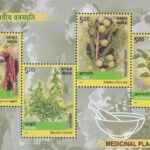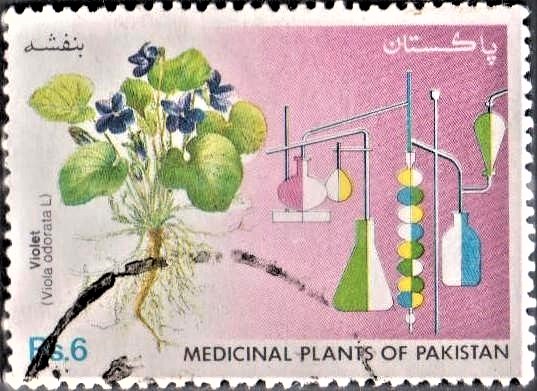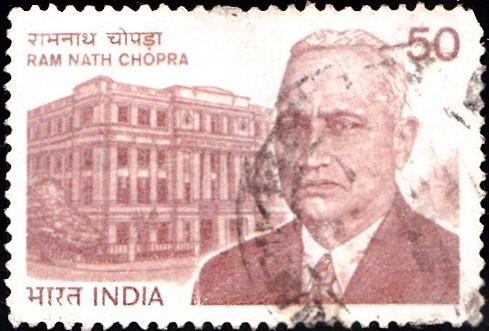
Indian Medicinal Plants 1997
Complete Set of 4 nos of commemorative postage stamps on the Medicinal Plants of India : Tulsi, Haridra, Sarpagandha and Ghritkumari :
Issued on Oct 28, 1997
Credits :
Stamps : Deptt. of ISM and Homeopathy
FDC : Brahm Prakash
Cancellation : Smt. Alka Sharma
Type : Stamps, Mint Condition
Colour : Multi Colour
Denomination : 200, 500, 1000 & 1100 Paise
Overall size : 4.80 x 3.60 cms.
Printing size : 4.35 x 3.15 cms.
Perforation : 13 x 13
Paper : Imported un w/m Adhesive Gravure Coated Stamp Paper in Sheets 50.8 x 53.5 cms.
Number per issue sheet : 6 Quadruplicate
Printing Process : Photogravure
Printer : India Security Press, Nasik
About :
- The Indian systems of medicine have been a part of the culture and tradition of India down the centuries. Vedas, the ancient Indian epics have devoted an important section to Ayurveda, the science to life. The basic concept in the Indian systems of medicine, namely, Ayurveda, Siddha and Unani relates to maintaining balance in the body between different elements of humours of which the body is made of. Any disturbance in the balance leads to disease and the therapy lies in restoring the balance through the use of medicines of natural origin such as herbs and minerals.
- India is endowed with a rich variety of medicinal plants. Eastern Himalayas and the Western Ghats are among the 18 crucial regions of bio-diversity in the world. Among the plants depicted in the series –
Tulsi :
- Ocimum Sanctum Linn. (Lamiaceae) is a plant worshipped for its medicinal values since time immortal. The juice of the leaves is used in catarrh and bronchitis and applied to the skin in ring-work and other cutaneous diseases. An infusion of the leaves is given to children in gastric disorders. A decoction of the root is given as diaphoretic in malarial fever. It drives away mosquitoes.
Haridra :
- Curcuma Longa Linn. (Zingiberaceae) is a perennial herb, native of Southern Asia and cultivated throughout India. The drug is considered as carminative in cases of diarrhoea and intermittent fevers, in disorders of blood, in affections of liver and jaundice, in non-tubercular respiratory diseases. A decoction of the rhizome is applied to relieve catarrh, scabies and certain skin diseases. The drug is extremely applied in pains and bruises and internally administered in disorders of the blood. Haridra can grow at all places ranging from sea level to an altitude of 1,220 metres but is very sensitive to atmospheric temperature.
Sarpagandha :
- Rauvolifa Serpentina Linn. (Apocynaceae) is probably one of the important contributions of ancient Indian medicine. The alkaloid reserpine present in the roots of this plant, has been proved to be an effective remedy against hypertension. Ayurvedic texts also describe its sedative and hypnotic actions. The drug has been effectively tried in cases of high blood pressure, insanity and schizophrenia. It is widely distributed in the sub-Himalayan tract, Assam, lower hills of Gangetic plains, eastern and western ghats, and some parts of Central India.
- The drug Rauvolifa consist of the air dried roots of the plant. Besides the roots, its liquid extract, the dried extract and the tincture are official in Indian Pharmacopoeia.
Ghrit Kumari :
- Aloe Barbadensis Mill. (Liliaceae) is a native of North Africa and found in semi-wild state in all parts of India, from the dry westward valleys of Himalayas upto Kanyakumari.
- The leaf juice is used in dyspepsia, burns, colic, hyperadenosis, hepatopathy, splenopathy, skin disease, constipation, vitiated condition of vata and pitta, abdominal tumours, dropsy, carbuncles, sciatica, lumbago and flatulence. The oleo-gum, is used for local application in painful inflammation, burns, chronic ulcers and catarrhal and purulent ophthalmia.
- The first day cover carries the depiction of “Shri Dhanwantri” who is revered as the originator of Ayurveda. Considering the relevance, the government has created a department of Indian System of Medicine and Homoeopathy to develop, promote, research and increase awareness to these systems of medicine.
- Text : Department of ISM and Homoeopathy.








[…] Continuing with the series that began on 28th October 1997, the Department of Posts now brings out another set of four stamps on the medicinal plants of […]
[…] Continuing with the series that began on 28th October 1997, the Department of Posts now brings out another set of four stamps on the medicinal plants of […]
[…] sources and their dispensations are elaborately dwelt upon. The medicinal properties of plants like Sarpagandha, Amla, Haldi and Neem were discovered and incorporated in dosage forms akin to modern day tablets, […]
[…] introduction and systematic study of the now well-known herb – Rauwolfia serpentina (i.e. Sarpagandha of Ayurveda) was possible due to Chopra’s original researches at the School of Tropical […]
[…] Gaudiya Vaishnava practice of meditation based on the soft recitation of the Hare Krishna mantra on Tulsi beads. In the year 1887, he joined Calcutta Metropolitan Institution (Vidyasagar College) and […]